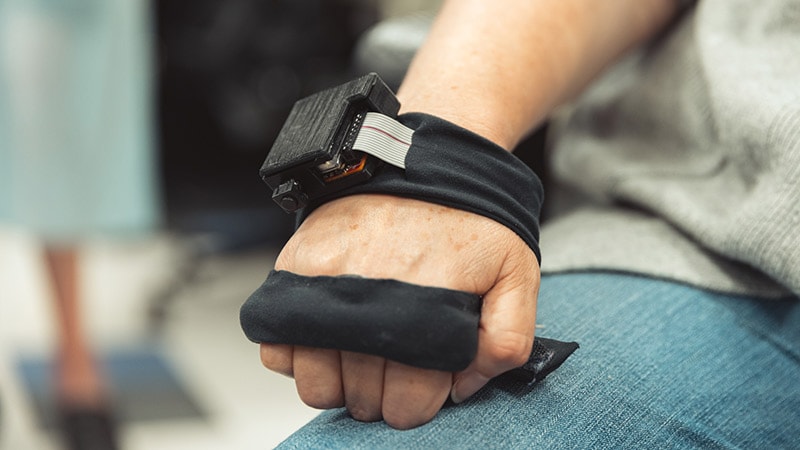Innovative Vibrating Glove for Stroke Recovery
Core Concepts
Vibro-tactile stimulation through a wearable vibrating glove may revolutionize stroke recovery treatment.
Abstract
The article discusses a groundbreaking wearable device developed by researchers at Stanford University and Georgia Tech for chronic stroke treatment. The device delivers subtle vibrations to the wrist and hand, potentially relieving spasticity more effectively than standard Botox injections. Key highlights include:
- Development of a vibrating glove for stroke recovery.
- Vibro-tactile stimulation as a potential treatment for spasticity.
- Research on vibration and stimulation therapies for neurological conditions.
- The device's impact on spasticity relief and potential long-term effects.
- Exploration of neuroplasticity and brain retraining through sensory signals.
- Future research directions and potential benefits of the device.
Customize Summary
Rewrite with AI
Generate Citations
Translate Source
To Another Language
Generate MindMap
from source content
Visit Source
www.medscape.com
Promising New Wearable Could Retrain the Brain After Stroke
Stats
"The vibro-tactile stimulation can be used at home, and we're hoping it can be relatively low cost," said senior study author Allison Okamura, PhD.
"More than half of the participants experienced equal or better results than another group that only received regular Botox injections."
"The stimulation is sending additional sensory signals to the brain, which helps the brain interpret and reconnect any lost circuits," Okamura said.
Quotes
"The stimulation is sending additional sensory signals to the brain, which helps the brain interpret and reconnect any lost circuits," - Allison Okamura, PhD
"The dream would be that you reach true rehabilitation, which is no longer needing the device," - Allison Okamura, PhD
Key Insights Distilled From
by Sarah at www.medscape.com 03-04-2024
https://www.medscape.com/viewarticle/promising-new-wearable-could-retrain-brain-after-stroke-2024a100044f
Deeper Inquiries
How does the potential long-term impact of the vibrating glove compare to traditional stroke recovery treatments?
The potential long-term impact of the vibrating glove in stroke recovery shows promising results compared to traditional treatments like Botox injections. While Botox injections may wear out over time and patients may run out of insurance coverage for rehabilitation, the vibrating glove offers a non-invasive, at-home solution that can potentially retrain the brain through neuroplasticity. The device's ability to send additional sensory signals to the brain and help interpret and reconnect lost circuits may lead to sustained symptom relief even after discontinuing its use. In a clinical trial, more than half of the participants experienced equal or better results than those receiving regular Botox injections, indicating the potential long-term benefits of the vibrating glove in stroke recovery.
What are the implications of the device's focus on neuroplasticity for future stroke rehabilitation methods?
The device's focus on neuroplasticity has significant implications for future stroke rehabilitation methods. By leveraging neuroplasticity, the device aims to retrain the brain by sending additional sensory signals that help interpret and reconnect lost circuits due to stroke-induced damage. This approach suggests a shift towards more holistic and brain-centered rehabilitation strategies that target the root cause of spasticity and motor function impairment. Future stroke rehabilitation methods could potentially incorporate similar neuroplasticity-focused devices to enhance recovery outcomes by promoting brain reorganization and restoring balance in neural circuits. This emphasis on neuroplasticity opens up new possibilities for innovative and effective stroke rehabilitation interventions that go beyond traditional treatments.
How might the incorporation of movement enhance the effectiveness of the device in stroke recovery?
Incorporating movement into the use of the vibrating glove could enhance its effectiveness in stroke recovery by synergistically engaging motor functions and sensory feedback. Movement is a key component of rehabilitation as it promotes muscle activation, joint mobility, and overall functional recovery. By encouraging patients to engage in movement while wearing the device, the vibrating glove can potentially amplify the brain retraining effects by reinforcing neural connections through active participation in rehabilitation exercises. Additionally, combining movement with vibro-tactile stimulation may facilitate sensorimotor integration, leading to improved motor control and coordination. The incorporation of movement not only complements the device's neuroplasticity-focused approach but also offers a more comprehensive and interactive rehabilitation experience for stroke survivors, potentially accelerating their recovery process.
0
